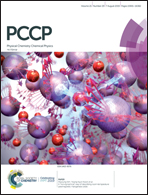A computational study on the electronic and optical properties of boron-nitride circumacenes†
Abstract
We report a comparative and systematic computational analysis on the electronic and optical properties of the boron-nitride-made (BN) counterparts of the carbon-made circumacenes. Recently, these planar molecules have attracted interest for applications in the condensed matter physics domain. In particular, we focus on the five first members of this BN-family (from BN-coronene to BN-circumpentacene) presenting a comparison with their carbon analogues. For all the systems investigated, we calculate different electronic properties and the optical absorption spectra, performing all electron Density Functional Theory (DFT) and Time Dependent-DFT (TD-DFT) calculations. In the context of ab initio calculations we select a localized Gaussian basis-set matched with a hybrid exchange–correlation functional. We discuss possible implications of the observed BN cluster properties, which could be an alternative material or complementar as compared to their carbon analogues. In particular, concerning the optical properties, we have found that the main difference between the two families is that the BN molecules absorb in the UV, rather than in the visible as happens for the C-made parents. Moreover, we demonstrate that the electronic and optical observables of the BN clusters are nearly independent of the cluster size in contrast to what happens for their carbonaceous counterparts.



 Please wait while we load your content...
Please wait while we load your content...